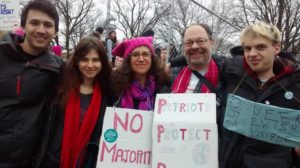Does Activism Matter? 20 Reasons to Say Yes!
Lifelong activist Emily Levy made a short video outlining 10 reasons why protests matter. In less than 15 minutes, she explores these benefits of participating in protests. Protests:
- Raise the cost to politicians of doing the wrong thing
- Heighten awareness both of the issue and that the issue has a constituency of people who care about it enough to take time out of their day
- Build momentum toward change, even systemic change (she notes Erica Chenoweth’s research that shows that a government will crumble if just 3-1/2 percent of the population engages in nonviolent resistance)
- Help participants feel less isolated
- Inspire others to show up, especially if you carry signs about why you’re marching
- Provide cathartic release: what she calls “a national scream”
- Create opportunities to get involved with organizations working on causes that matter to you
- Offers a voice to oppressed and powerless groups that would risk to much if they were actively protesting
- Allow even very small numbers to bear witness (I personally have conducted some one-person protests, so this resonates deeply with me)
- Facilitate ways to harness your skills, beliefs, and connections to make bigger and more lasting change
It’s a great list, but it’s only the beginning. Here are ten more that I came up with very quickly. I’d love you to add to the list as well:
While Emily wrote her list back in 2019, it’s all still not only true but relevant. A few things have changed, though–some good, some bad:
- Dozens of new ways of protesting were invented or popularized during the pandemic, adding to more than 200 we already had
- Repressive right-wing governments have been forced from power in countries such as the US and Brazil–but took or consolidated power in Israel, Hungary, Turkey, and India
- Putin has started a criminal and brutal war against Ukraine
- In the US, the ultra-right has taken over the Supreme Court and several state legislatures, catalyzing a whole new generation of activists–and in election after election, progressives are winning big in places they weren’t expected to
- Black Lives Matter and reproductive rights protests reached critical mass


